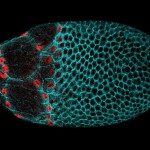Lien vers Pubmed [PMID] – 16330189
Mech. Dev. 2006 Jan;123(1):3-16
Msx and Dlx homeoproteins control the morphogenesis and organization of craniofacial skeletal structures, specifically those derived from the pharyngeal arches. In vitro Msx and Dlx proteins have opposing transcriptional properties and form heterodimeric complexes via their homeodomain with reciprocal functional repression. In this report we examine the skeletal phenotype of Msx1; Dlx5 double knock-out (DKO) mice in relationship with their expression territories during craniofacial development. Co-expression of Dlx5 and Msx1 is only observed in embryonic tissues in which these genes have independent functions, and thus direct protein interactions are unlikely to control morphogenesis of the cranium. The DKO craniofacial phenotypes indicate a complex interplay between these genes, acting independently (mandible and middle ear), synergistically (deposition of bone tissue) or converging on the same morphogenetic process (palate growth and closure). In the latter case, the absence of Dlx5 rescues in part the Msx1-dependent defects in palate growth and elevation. At the basis of this effect, our data implicate the Bmp (Bmp7, Bmp4)/Bmp antagonist (Follistatin) signal: in the Dlx5(-/-) palate changes in the expression level of Bmp7 and Follistatin counteract the reduced Bmp4 expression. These results highlight the importance of precise spatial and temporal regulation of the Bmp/Bmp antagonist system during palate closure.
